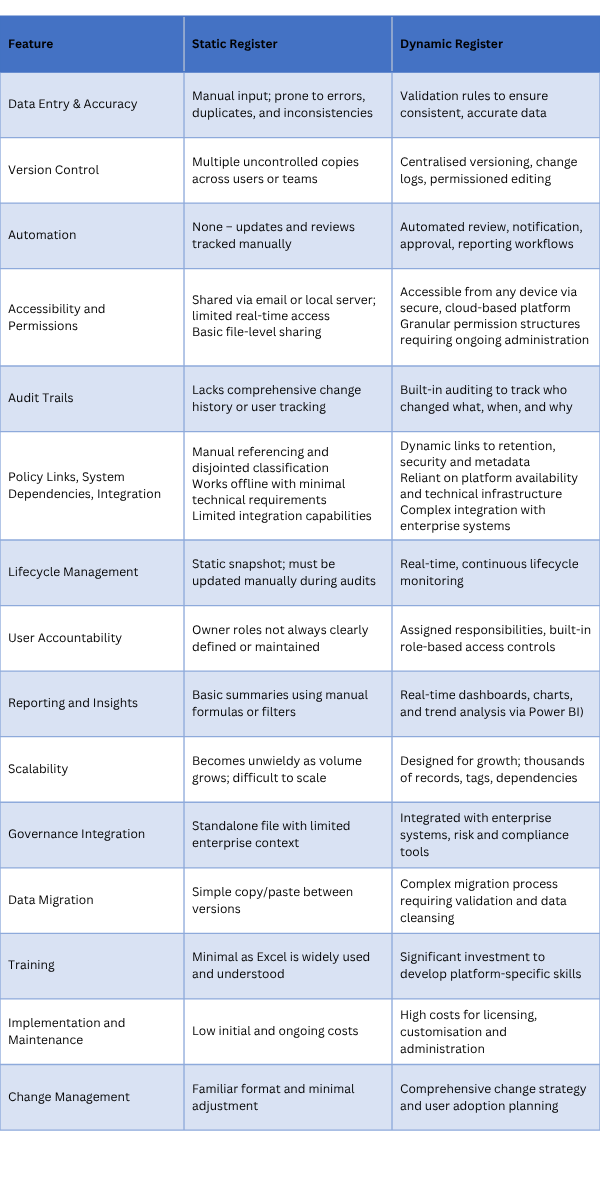IM BLOG: From Static Spreadsheets to Smart Systems - Evolving the IAR

Today traditional approaches to information asset management are increasingly insufficient. While this course has used the typical Excel-based information asset register, once a staple in records and information management programs, this methodology is often seen as an inflexible option that struggles to meet the demands of modern organisations. As information ecosystems become more complex, interconnected and compliance-driven, static spreadsheets are showing their age and their limitations.
Limitations of static spreadsheets
Excel spreadsheets have served as the foundation for information asset registers for decades. However, these static documents quickly become outdated and require manual maintenance. Unless tightly controlled, the distributed nature of Excel files also may result in version control issues with multiple competing "sources of truth" circulating throughout the organisation. Perhaps most critically, spreadsheet-based registers lack the very capabilities on which modern information governance depends: automated workflows, audit trails, access controls and systematic review cycles. In short, they document what you have, but they can't help you manage it effectively.
A smarter way - dynamic registers
Enter dynamic platforms like SharePoint and Jira, tools that transform the information asset register from a simple list to a living, integrated system. A dynamic information asset register represents a fundamental shift in information asset management philosophy offering real-time visibility into information holdings while reinforcing distributed accountability models.
In SharePoint, information asset registers become part of the Microsoft 365 ecosystem, where they can link directly to policies, user permissions, retention schedules and Power BI dashboards. You can enforce structured data entry, create alerts for overdue reviews and automate approval workflows using Power Automate, none of which is possible in Excel.
With Jira, you move from passive documentation to active management. Built-in workflow automation, custom fields and lifecycle triggers mean information assets can be reviewed, classified and reassessed continuously, not just once a year. Connections between assets and the systems, processes, or regulations they relate to can be created , giving the register real-world context that spreadsheets can’t replicate.
Benefits and risks of dynamic registers
The transition to dynamic information asset registers delivers substantial benefits for information governance:
- centralised accessibility where everyone works from the same, current version of the truth, accessible from anywhere, on any device
- built-in governance with workflow automation applying review cycles, classification updates and ownership accountability without chasing people via email
- transparency and trust through versioning, audit logs and role-based access providing assurance to auditors, leadership and regulators
- real-time intelligence, monitoring and decision-making, critical for risk mitigation, compliance, and business continuity.
While dynamic information asset registers offer significant advantages, several risks must be addressed during conversion:
- information loss, corruption or misclassification due to data migration challenges
- robust permission structures to prevent oversharing or unauthorised access, exposure of sensitive information assets or creation of security vulnerabilities
- skills gap when transitioning from familiar spreadsheets to specialised platforms
- system dependencies introducing new points of failure from downtime or maintenance
- implementation costs such as licensing fees, customisations and administration
- change resistance as users resist adopting new workflows and interfaces
- legacy systems data silos if integrations aren't properly established
- version control during transition requires careful planning to ensure business continuity while maintaining data integrity across both systems during the changeover period.
Compare the features of a static and dynamic information asset register.
Translating the static register into a dynamic format
At its base level, an information asset register is a group of data terms and metadata fields that give context and build knowledge for the reader. This format means that an asset register is easy to convert into a dynamic, web-based format in any relational database system.
Below is an example of the National Archives of Australia’s Streamlined Information Asset Register built into a SharePoint List.


Tips and tricks for building a dynamic register
- Preference pre-set ‘pick list’ fields over free text options. This allows for a greater level of data accuracy.
- Use baseline metadata fields as a ‘jumping off’ point to build on. Add fields that are relevant and valuable to business users.
- Metadata is power! The more categorisation you have for your asset register, the more you will be able to build views, analysis and business insights from your information.
Think beyond a register, think operational intelligence
A dynamic information asset register is more than a smarter spreadsheet. It’s a living record of an organisation’s knowledge, obligations and value, one that grows and adapts with the business. It shifts the register from a records management project into the operations of your governance model.
So if your information asset register is in Excel, now might be the time to reimagine what your register could be. Because in the modern information age, smart tools are essential.


